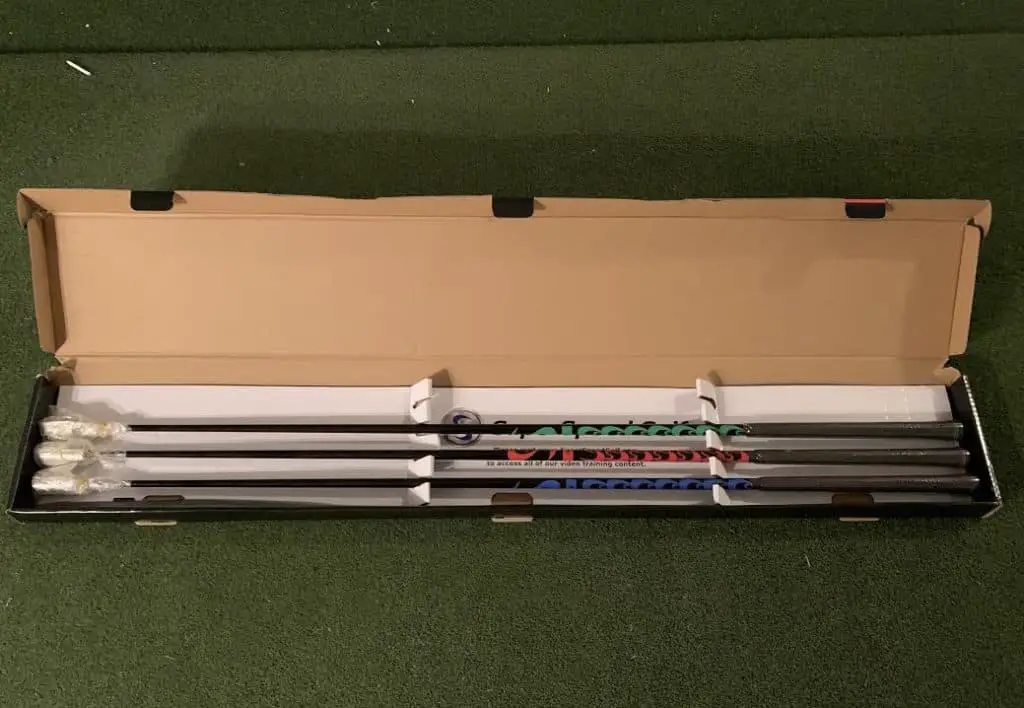The game of golf is all about being able to hit the golf ball close when you have scoring opportunities.
Taking into account that the PGA Tour make percentage from 8 feet is only 50%. This shows the importance of giving yourself many opportunities over the course of a round.
I would consider scoring opportunities for most golfers as anything inside of 130 yards, or when they get to their 9 iron or smaller club. Making sure you have the proper club setup is essential to scoring.
If you have gaps in distances and end up having to take too much off a club or over swing, you decrease your chances of hitting a quality shot, close enough to the hole to have a realistic scoring opportunity.
Enter the pitching wedge, the pitching wedge is an essential club and one that I am going to dive into today and give a complete overview of everything related to the pitching wedge.

What is the loft of a pitching wedge?
The loft of a pitching wedge is between 45 and 48 degrees. Golfers typically use the pitching wedge between 100 and 125 yards depending on their swing speed and the loft of the club.
Pitching wedges for many years were always at 48 degrees loft. However, in the past decade, golf club manufacturers have made the lofts of most irons “stronger” (less loft) than the past.
There is typically 4 degrees in loft between each iron in the set of clubs. For example, when the pitching wedge was 48 degrees, the 9 iron was 44 degrees and the 8 iron was 40 degrees. Now, when the pitching wedge is 45 degrees, the 9 iron is 41 degrees, and an 8 iron is around 37 degrees.
This was done to make golfers think they are hitting their new clubs further. For example, if you are testing out which new irons to buy and you grab an 8 iron to test and you now hit it 150 yards vs 143 yards, you think these clubs are really something special. When in reality, you have 3 degrees less loft and are hitting more of a 7 iron.
Why is this important to know? It becomes very important because of the gaps that might exist when we get to the pitching wedge. If your pitching wedge is 45 degrees and your next club is a 54 degree sand wedge, you have at least a two club gap in your wedges.
Closing the gap between pitching wedge and sand wedge
Even when the standard pitching wedge loft was 48 degrees, the standard loft of a sand wedge was 56 degrees. Once again with 8 degrees in loft between the two clubs, there is a missing wedge in here.
Enter the gap wedge. Many golfers started carrying the gap wedge at around 52 degrees to ensure there wasn’t a major gap in distance and difficult to control. For example, if someone hit their pitching wedge 125 yards and could only hit their sand wedge 105 yards, they may consider adding the gap wedge to be able to better control the 115 yard shot.
Many golfers will choose to only have 4 degree between each of their wedges, while some may select to have a 6 degree gap in their wedges, which provides more opportunity to add an additional hybrid, fairway wood or long iron to their bag.
What options do golfers have with their wedges?
There are several different options a golfer has when setting up their wedges.
Here are a couple of options:
- If the pitching wedge is 48 degrees. The golfer could either have a 54 degree sand wedge and a 60 degree lob wedge or have a 52 degree gap wedge, a 56 degree sand wedge and a 60 degree lob wedge.
- If the pitching wedge is 45 degrees. The golfer could go with a 50 degree gap wedge, 54 degree sand wedge and a 58 degree lob wedge. Or the golfer could go with a 50 degree gap wedge, a 55 degree sand wedge and a 60 degree lob wedge.
I have a 48 degree pitching wedge and carry a 54 degree sand wedge and a 60 degree lob wedge. I am able to control the 6 degree gaps in loft by hitting different flighted wedges as I prefer to hit the 3 quarter wedge shot.
My favorite club for chipping and pitching is my 60 degree wedge as more and more golf courses have firm, difficult greens and the loft on a 60 degree wedge is rather beneficial!

How can a golfer measure what wedges are best for their game?
I would highly recommend a portable launch monitor. I know that you might be thinking, “but I can’t afford a Trackman” and the good news is that you don’t have to be able to afford one as there are some very quality options in the 500 to 2000 dollar price range.
I own a SkyTrak launch monitor that I use in my golf simulator setup and can take to the driving range or golf course. I know spot on, how far I hit my full swing pitching wedge, sand wedge and lob wedge. I also know my distances for a 3 quarter shot with each club.
When a golfer is able to chart out these distances, it is an easy reference guide when on the golf course! It takes the pressure off and a golfer can know what shot he or she needs to to hit.
Here are my top 3 recommend affordable golf launch monitors:
If you visit any PGA Tour stop you will see the majority of professionals use a launch monitor at some point throughout the week . Many are monitoring their clubface, swing path relationship as well as swing speed. These are important numbers to monitor to make sure you are keeping your swing within a certain range.
Dustin Johnson simply uses his launch monitor to measure the distances of his wedges. There are so many advantages to having this technology as part of your setup! It can help you chart all of your distances, test out different clubs and even how difference golf balls perform.
I would highly recommend then ensuring you have the right yardage on the golf course by having a rangefinder in your bag:
How far should I hit my pitching wedge?
There really isn’t a specific distance that you should hit your pitching wedge, but many golfers will use their pitching wedge from 100 to 125 yards.
Of course there are golfers with slower swing speeds and faster swing speeds that might push this number as low as 75 and all the way up to 140 yards. The key isn’t how far you hit it, but can you hit the distance you need. This is where the portable launch monitor is important.
If you want to add speed to your game, there are great options like SuperSpeed Golf to help you gain 5-8% swing speed, which could mean 20-30 yards in driving distance. I was able to gain 7-10 miles per hour through my training with SuperSpeed Golf (see below for more details).
Full review on SuperSpeed Golf here.
How to chart out your wedge distances?
I would recommend doing the following to know the distances you hit each of your wedges in your bag. Follow this routine:
- Get access to a launch monitor.
- Take all of your wedges and hit 100%, 90%, and 80% shots.
- Track your distances and hit 5 shots at each percentage.
- Take the average carry distance.
- Create a chart that might look something like this below
| Club | Carry Distance (100%) | 90% | 80% |
| 4 iron | 190 | ||
| 5 iron | 181 | ||
| 6 iron | 171 | ||
| 7 iron | 163 | ||
| 8 iron | 153 | ||
| 9 iron | 143 | ||
| P Club | 130 | ||
| PW Club | 118 | 110 | 102 |
| SW Club | 105 | 97 | 91 |
| LW Club | 90 | 82 | 74 |
When to use a pitching wedge?
A pitching wedge could be used for golf shots between 100 and 125 yards for most golfers.
However, the pitching wedge can also be used around the green for chip shots and pitch shots. While, I do believe at a minimum every golfer should have a sand wedge and potentially a lob wedge, the pitching wedge can still be used for certain chip shots.
When there is enough green to work with, keeping the ball lower to the ground and letting it roll out can be very helpful for many golfers.
The pitching wedge could also be used for longer greenside bunkers when you have to carry the ball a further distance and the lip of the bunker is low enough.
With the difficulty of green designs and the speed of greens, many golfers will want to have a sand wedge and a lob wedge, but don’t forget about the ease of hitting the pitching wedge on chip shots when you have plenty of green to work with.
How to hit a pitching wedge?
The golfer will use a similar full swing to other clubs. The pitching wedge is one of the shorter clubs in the bag, so you are closer to the ball resulting in a swing that may be a little more upright.
You will want to play the ball in the middle of your stance and maybe even back in your stance if you are trying to flight your golf ball lower into the green because of the pin placement or the wind conditions.
What wedges are the best?
I prefer the Cleveland wedges, however, there are many great options out there.
More Info on SuperSpeed Golf
I mentioned above that I was able to increase my swing speed by 7-10 miles per hour on average with through training with the SuperSpeed Golf System. This overspeed training protocol is based on the science surrounding overspeed training. The concept is that you will swing and train with lighter clubs and one heavier club to train the body and mind to be able to swing faster. In order to swing faster, you have to train to swing faster.
This every other day program that only takes a 15 minute training session every other day can add to 5-8% in swing speed, which could mean 20-30 yards in total distance with your driver. Are you ready to commit to this routine every other day and take your swing speed to the next level? Check out the current pricing below at SuperSpeed Golf!

Take Action – What You Can Do Today to Get Better
What does this mean for you? I believe in the following recipe to get better:
1 – Improve your motion in the golf swing by identifying a golf instructor. Here are some options:
Here is a list of golf instructors that we have reviewed:
2 – Train to swing faster and improve your swing speed. Here are some options:
Looking to gain more Speed and Distance in your swing. Two Options:
3 – Understand course strategy and work to break through your next barrier. Here is a series on breaking through:
We have provided guides on how to break 100, 90, 80 and 70. Check out more below, if interested.
4 – Practice Frequently
Did you know that I build a golf simulator in my garage and have played over 500 rounds of golf on my SkyTrak system? It has been a game changer and one worth checking out. Here are some of my other posts on golf simulators frequently asked questions:
- Is a Golf Simulator Worth It?
- How to Build a Golf Simulator?
- What is the Best Golf Simulator?
- Golf Simulator Accessories?
- How to Build a Golf Simulator for under $7000
- Top 11 Reasons to Buy a SkyTrak
- How to Build a Golf Simulator for Under $1000
- Why Build A Golf Simulator?
- What Space is Needed?
- Can A Golf Simulator Improve My Game?
- How Much Does A Golf Simulator Cost?
- Don’t Forget to Check out our 15 best golf swings of all time.

